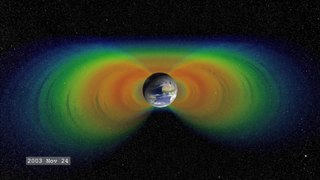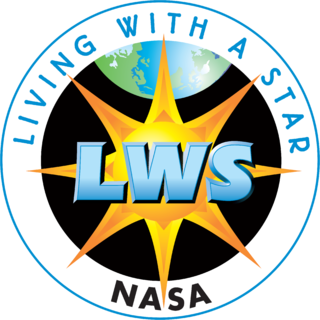
A magnetosphere is a region of space surrounding an astronomical object in which charged particles are manipulated or affected by that object's magnetic field. It is created by a planet having an active interior dynamo.

A Van Allen radiation belt is a zone of energetic charged particles, most of which originate from the solar wind, that are captured by and held around a planet by that planet's magnetic field. Earth has two such belts and sometimes others may be temporarily created. The discovery of the belts is credited to James Van Allen, and as a result, Earth's belts are known as the Van Allen belts. Earth's two main belts extend from an altitude of about 640 to 58,000 km above the surface in which region radiation levels vary. Most of the particles that form the belts are thought to come from solar wind and other particles by cosmic rays. By trapping the solar wind, the magnetic field deflects those energetic particles and protects the atmosphere from destruction.

Pioneer 3 was a spin stabilized spacecraft launched at 05:45:12 UTC on 6 December 1958 by the U.S. Army Ballistic Missile Agency in conjunction with the NASA, using a Juno II rocket. This spacecraft was intended as a lunar probe, but failed to go past the Moon and into a heliocentric orbit as planned, but did reach an altitude of 102,360 km before falling back to Earth. The revised spacecraft objectives were to measure radiation in the outer Van Allen radiation belt using two Geiger-Müller tubes and to test the trigger mechanism for a lunar photographic experiment.
Luna 2, originally named the Second Soviet Cosmic Rocket and nicknamed Lunik 2 in contemporaneous media, was the sixth of the Soviet Union's Luna programme spacecraft launched to the Moon.
A ring current is an electric current carried by charged particles trapped in a planet's magnetosphere. It is caused by the longitudinal drift of energetic particles.

Explorer 4 was an American satellite launched on July 26, 1958. It was instrumented by Dr. James van Allen's group. The Department of Defense's Advanced Research Projects Agency had initially planned two satellites for the purposes of studying the Van Allen radiation belts and the effects of nuclear explosions upon these belts, however Explorer 4 was the only such satellite launched as the other, Explorer 5, suffered launch failure.

James Alfred Van Allen was an American space scientist at the University of Iowa. He was instrumental in establishing the field of magnetospheric research in space.

The magnetosheath is the region of space between the magnetopause and the bow shock of a planet's magnetosphere. The regularly organized magnetic field generated by the planet becomes weak and irregular in the magnetosheath due to interaction with the incoming solar wind, and is incapable of fully deflecting the highly charged particles. The density of the particles in this region is considerably lower than what is found beyond the bow shock, but greater than within the magnetopause, and can be considered a transitory state.

The magnetosphere of Saturn is the cavity created in the flow of the solar wind by the planet's internally generated magnetic field. Discovered in 1979 by the Pioneer 11 spacecraft, Saturn's magnetosphere is the second largest of any planet in the Solar System after Jupiter. The magnetopause, the boundary between Saturn's magnetosphere and the solar wind, is located at a distance of about 20 Saturn radii from the planet's center, while its magnetotail stretches hundreds of Saturn radii behind it.
The following is a chronology of discoveries concerning the magnetosphere.

The plasmasphere, or inner magnetosphere, is a region of the Earth's magnetosphere consisting of low energy (cool) plasma. It is located above the ionosphere. The outer boundary of the plasmasphere is known as the plasmapause, which is defined by an order of magnitude drop in plasma density. The plasmasphere was discovered in 1963 by Don Carpenter from the analysis of VLF whistler wave data. Traditionally, the plasmasphere has been regarded as a well behaved cold plasma with particle motion dominated entirely by the geomagnetic field and hence corotating with the Earth.
Space physics is the study of plasmas as they occur naturally in the Earth's upper atmosphere (aeronomy) and within the Solar System. As such, it encompasses a far-ranging number of topics, such as heliophysics which includes the solar physics of the Sun: the solar wind, planetary magnetospheres and ionospheres, auroras, cosmic rays, and synchrotron radiation. Space physics is a fundamental part of the study of space weather and has important implications in not only to understanding the universe, but also for practical everyday life, including the operations of communications and weather satellites.

Living With a Star (LWS) is a NASA scientific program to study those aspects of the connected Sun-Earth system that directly affect life and society. LWS is a crosscutting initiative with goals and objectives relevant to NASA's Exploration Initiative, as well as to NASA's Strategic Enterprises. The program is managed by the Heliophysics Science Division of NASA's Science Mission Directorate.

The magnetosphere of Jupiter is the cavity created in the solar wind by the planet's magnetic field. Extending up to seven million kilometers in the Sun's direction and almost to the orbit of Saturn in the opposite direction, Jupiter's magnetosphere is the largest and most powerful of any planetary magnetosphere in the Solar System, and by volume the largest known continuous structure in the Solar System after the heliosphere. Wider and flatter than the Earth's magnetosphere, Jupiter's is stronger by an order of magnitude, while its magnetic moment is roughly 18,000 times larger. The existence of Jupiter's magnetic field was first inferred from observations of radio emissions at the end of the 1950s and was directly observed by the Pioneer 10 spacecraft in 1973.

The Van Allen Probes, formerly known as the Radiation Belt Storm Probes, are two robotic spacecraft being used to study the Van Allen radiation belts that surround Earth. NASA is conducting the Van Allen Probes mission as part of the Living With a Star program. Understanding the radiation belt environment and its variability has important practical applications in the areas of spacecraft operations, spacecraft system design, mission planning and astronaut safety. The probes were launched on 30 August 2012.
The health threats from cosmic rays is the danger posed by galactic cosmic rays (GCR) and solar energetic particles to astronauts on interplanetary missions or any missions that venture through the Van-Allen Belts or outside the Earth's magnetosphere. They are one of the greatest barriers standing in the way of plans for interplanetary travel by crewed spacecraft, but space radiation health risks also occur for missions in low Earth orbit such as the International Space Station (ISS).
The Injun program was a series of six satellites designed and built by researchers at the University of Iowa to observe various radiation and magnetic phenomena in the ionosphere and beyond.
There are risks associated with never-done-before technologies like the construction and operation of a space elevator. A space elevator would present a navigational hazard, both to aircraft and spacecraft. Aircraft could be dealt with by means of simple air-traffic control restrictions. Impacts by space objects such as meteoroids, satellites and micrometeorites pose a more difficult problem for construction and operation of a space elevator.
Daniel N. Baker is an American space scientist. He is the Distinguished Professor of Astrophysical and Planetary Science at the University of Colorado Boulder and director of the Laboratory for Atmospheric and Space Physics. He received his B.A. from the University of Iowa in 1969 and his Ph.D. from the same institution in 1974. In 2010 he was elected to the National Academy of Engineering for "leadership in studies, measurements, and predictive tools for the Earth's radiation environment and its impact on U.S. security."

Mei-Ching Hannah Fok is a Planetary Scientist at the Goddard Space Flight Center. She was awarded the NASA Exceptional Scientific Achievement Medal in 2011 and elected a Fellow of the American Geophysical Union in 2019. She has worked on the IMAGE, Van Allen Probes and TWINS missions.













